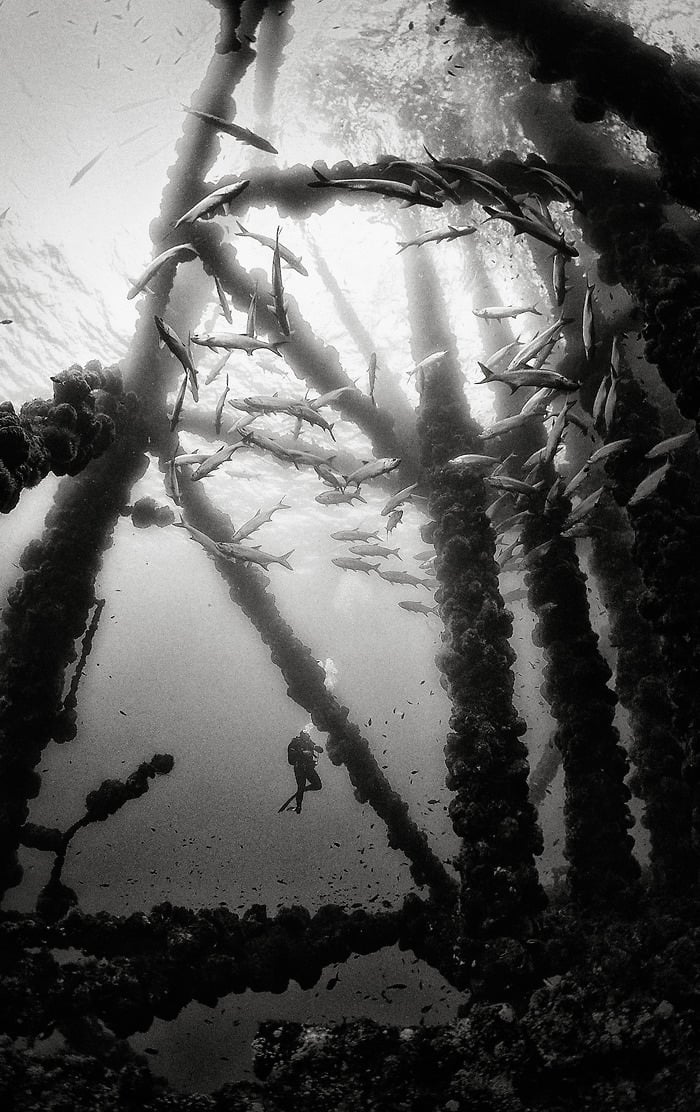Sanctuaries of the Dying Sea
Contributor
Reciprocal Landscapes
“…In the glow of the thing’s own flame they saw edificial flanks, the concrete and rust of them, the iron of the pylon barnacled, shaggy with benthic growth now lank gelatinous bunting,” writes China Miéville in documenting the reader’s first encounter with a sentient oil platform ascending ashore in her short story Covehithe. Here, the imagery of the apparatus creates a visual language grounded in the material complexity of the intersection between the industrial and biological. Indeed, the coral reefs are a part of the machine imagery as much as the oil platform itself, suggesting that these concepts are closely interwoven rather than opposing binaries.
As many of the Signal Hill offshore platforms are simultaneously approaching the end of their life cycle and are about to be decommissioned, the seascape of Santa Barbara Channel, California, is preparing to confront a series of drastic alterations. Since the discovery and the immediate exploitation of the Long Beach Oil Field exactly a century ago, the city’s horizon has been dominated by the glister and gleam of numerous oil platforms constructed from the 1920s through the 1960s. Today, Holly Platform is among the 23 historic platforms that are in the process of removal from the ocean floor; it is cheaper to dispose of it than to continue to operate it. Altogether, the cost of decommissioning the entire ensemble is estimated at $1.6 billion. Usually, the corrosive parts of the platforms are dismantled, shipped to the coast, and recycled, while the underwater elements in most cases are simply exploded.
When the assemblage comes ashore, it reveals the complexity of life underneath—the incidental geoengineering of the platform spars has created inhabitable spaces for hundreds of marine species, from fish to arthropods, through the artificial reef growth formed by years of operation. These arrangements tend to follow a particular urban form—the water column hosts temporary/transitory fish groups, while the bottom areas act as nurseries for larger species in the caves formed by the diagonal steel bracing placed to counteract the deepwater currents. Around the platform, a new type of dwelling emerged—unique arrangements of shell mounds formed by the aggregated assemblies of those species that fell off the platform and remained on the seafloor. Moreover, the interconnected wells stemming from the spar facilitate vibrant communities between multiple platforms, enhancing biodiversity and its natural cycles. Current restrictions prohibit fishing within the vicinity of operations, creating a relatively undisturbed wildlife sanctuary otherwise impossible in the barren clay landscape of the channel.
Despite the negative connotation of the artificial and the irreversibility of the damage already done, these new ecosystems are learning to develop into something else. Lea-Anne Henry (University of Edinburgh) affirms that the artificial reefs in certain parts of the North Sea are not only functional but are continually evolving to increase their network and resemble their natural counterparts. In a closer study, marine scientist Milton Love concluded that relative to the organically formed coral reefs, certain species densities (ex. Rockfish) are higher in the platform ecosystems, and there is no difference in the levels of contamination. Whether by developing new habits or following the old rituals, there is a space of exchange; the California State Marine Fish, Garibaldi, are cultivating their nests amid the red algae growing in the spar trusses. Here, the relationship with industrial heritage becomes productive and restorative.
The ultimate fate of California’s industrial heritage is still pending; currently, the uncertainty of leaving the offshore infrastructure in place versus the ethics of its complete removal dictates the debate. Both sides, however, are reluctant to acknowledge the impact that we, as humans, have on the environment in relation to other environmental actors—machines, waste, marine bacteria—that populate our culture in a similar manner and narrate the life and death of our assemblages. What would the shifting landscapes of the future look like once we work with the instrumentalities beyond our own? In moving forward, fostering a reciprocal relationship is a complex but essential undertaking to facilitate meaningful change.

References
- Chapman, Sasha. “Oil Rigs Are a Refuge in a Dying Sea.” Hakai Magazine, 2022. https://hakaimagazine.com/features/oil-rigs-are-a-refuge-in-a-dying-sea/.
- Grothe, Solveig. “Mexiko: Bohrinsel Vor Der Golfküste Wird Taucher-Paradies.” DER SPIEGEL, August 13, 2017. https://www.spiegel.de/reise/fernweh/mexiko-bohrinsel-vor-der-golfkueste-wird-taucher-paradies-a-1157225.html.
- Yamamura, Jean. “Say so Long to Santa Barbara’s Offshore Platforms.” The Santa Barbara Independent, January 19, 2022. https://www.independent.com/2022/01/19/so-long-offshore-platforms/.